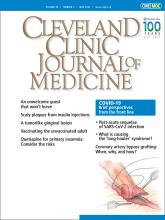A 68-year-old man with psoriasis and type 2 diabetes mellitus was seen as an outpatient for management of his diabetes. On examination of subcutaneous insulin injection sites, 2 large erythematous scaly plaques were noted on the abdomen (Figure 1). The patient said he noticed these lesions shortly after he began injecting insulin in his abdomen 5 years ago. He had continued injecting insulin to the same sites on his abdomen. He had never had lesions on his abdomen before he started insulin injections.
Erythematous, scaly plaques 5 cm by 5 cm at subcutaneous insulin injection sites.
Closer examination of the skin of the abdomen revealed 2 well-defined, erythematous, scaly plaques, measuring 5 cm by 5 cm.
The patient was prescribed a concentrated short-acting insulin and advised to change his injection sites to the arms, hips, or legs.
On a follow-up call 2 months later, he reported that the abdominal lesions had improved with a change in injection site and use of a topical steroid cream, and that no new lesions had developed.
KOEBNER PHENOMENON
Koebner phenomenon was first described by Heinrich Koebner in 1876 as the appearance of new psoriatic skin lesions at previously unaffected sites due to cutaneous trauma such as bruises, tattoos, and horse bites.1,2 It has also been described in lichen planus and vitiligo.1–3
The pathogenesis of Koebner phenomenon is not well understood.1 Our case demonstrates an isomorphic response or Koebner phenomenon due to trauma induced by subcutaneous insulin injections in a patient with preexisting psoriasis. The condition can occur at sites not previously affected by psoriasis, such as the abdomen in our patient.2 The phenomenon can take from 3 days to 2 years to develop after trauma.2,3
The differential diagnosis includes conditions such as Wolf isotopic response, reverse Koebner phenomenon (also called Renbök, which is Koebner spelled backwards in German), pseudo-Koebner phenomenon, and pathergy. In Wolf isotopic response, new dermatosis appears in the same areas as previous cutaneous lesions. Reverse Koebner phenomenon involves clearing of skin lesions after trauma. Pathergy can lead to trauma-induced skin lesions like papules and pustules, unlike in Koebner phenomenon in which the skin lesion reflects the underlying skin condition.4,5
Koebner lesions are usually treated in the same way as the underlying dermatosis.4
DISCLOSURES
The authors report no relevant financial relationships which, in the context of their contributions, could be perceived as a potential conflict of interest.
- Copyright © 2021 The Cleveland Clinic Foundation. All Rights Reserved.







